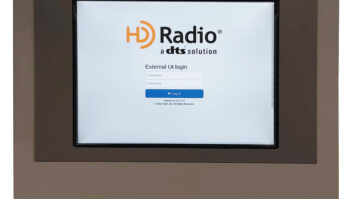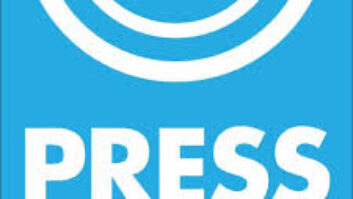
I spent more than two hours last week listening to a prototype armband HD Radio portable made by KRI and now available at Best Buy under its Insignia brand name for just under $50. It looks similar to the unit iBiquity demoed at CES and the spring NAB this year.
This new model is definitely more of an outdoor unit; I was able to receive several digital multicast stations outside but few of those stations from inside our office building as I sat by a window.
Though supplied with ear buds, I used my own. IBiquity’s instructions are correct that the cord, which acts as an antenna, does work better when it’s extended.
Outside, I was able to hear eight multicast channels and 14 main HD channels once I got the hang of using the unit. The difference between analog FM and HD was dramatic. Just like tabletop units, the frequency first locks in on analog and then the digital kicks in two to three seconds later and the HD symbol lights up. (Though it’s hard to see that symbol light up when you’re outside because other text displayed on the screen, like calls and song title and artist, are larger and brighter.) It also tuned in several analog-only FMs, and they sounded like it, complete with static and multipath.
The portable has two ways to locate stations, with manual tuning or a Seek function. A plus sign next to the “HD1” display lets you know there are more channels to hear. IBiquity had that on the directions, but it took me awhile to figure out how hard to push the Seek button to switch between the main and multicast channels then and back again without jumping to the adjacent station.

There were a couple of instances outside when the unit couldn’t lock onto a multicast signal and would display “HD2 no longer available.” In one case I know that station is on, the unit just couldn’t lock on for some reason and in the other case, I’m not sure if the multicast channel is still on.
Most of the multicast channels I heard were HD2s. I did hear two HD3s. One was strong and showed no difference in quality compared to its HD2 and HD main. In the other case, the HD3 had dropouts.
Though consumers buying this unit will receive a list of all HD stations in their area I did not use one because I just wanted to scan the dial and see what I could hear. Generally, I noticed if a station remained in analog, its RDS display was static but most of the HD text displays scrolled and many of them contained song title and artist information.
Once it locks onto a station, the display only shows up for a few seconds and that was annoying. It also took awhile to get used to all the waiting … waiting for the station to tune in initially and then for the digital to kick in. But once it did, I could quickly switch back and forth between a main and multicast channel then and back again.
The difference between what the unit could receive indoors vs. outdoors was vast and I’d be curious to know how the experience would be changed if a digital power increase were approved.








